 |
Fort Edward
Windsor, Nova Scotia, Canada
|
|
 |
Constructed: 1750
Used by: United Kingdom
Conflict in which it participated:
Father La Loutre's War
French & Indian War
|
Built to protect what would heroically become the oldest standing blockhouse in North America, Fort Edward was named for the founder of Nova Scotia's spectacular Halifax Citadel.You never forget the first time you take and hold another power's colonial possession. For Britain, this memorable event occurred in 1710, in the form of the previously French-owned colony of Acadia. |
 |
|
|
America, North and South, was of great interest to Europe. Imagine living in an increasingly cramped, centuries-old, dynamically squabbling society such as Europe, and then realizing that there existed, o'er the ocean to your west, a whole 'nother continent which was, for all intents and purposes, absent of any pre-existing human life. Spain, the Netherlands, Portugal, France and Great Britain all went to great lengths to secure as much of the New World as humanly possible in the Age of Discovery. Spain, Portugal and the Netherlands wound up concentrating most of their efforts in Central- and South America, eventually leaving France and Britain to duke it out in the northern hemisphere.
New France included an enormous chunk of what is today Canada, and the folks who put down roots in much of this area through the 17th century were known as Acadians. The Acadians got on relatively well with the native Indians (better than the English ever did, anyway) and, had they been left to their own devices, surely would have developed into one of the world's great societies. What would an umolested Acadia have been like in the 21st century? Interesting but moot, because it was an historic imperative that anything that was French had to be violently contested by the British, and vice-versa.
|
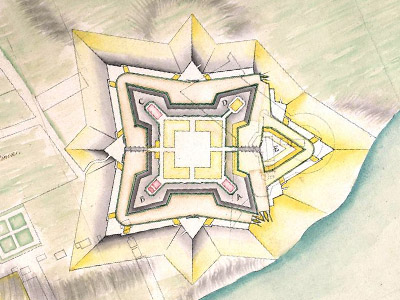 A sadly no-longer-extant starfort whose pedigree was impressive indeed: Port Royal's citadel in 1702. A sadly no-longer-extant starfort whose pedigree was impressive indeed: Port Royal's citadel in 1702. |
 |
Fanciful, semi-historical musings aside, the French capital of Acadia was Port-Royal, on what is now Nova Scotia. Initially founded as a Scottish colony called Charles Fort in 1629, 'twas handed over to the French in 1632 thanks to the Treaty of Saint-Germain-en-Laye (1632), which had concluded the latest war betwixt Britain and France. The French renamed the settlement Port-Royal, and built themselves what appears to have been a very nice starfort to celebrate their acquisition.
One thing led to another, and in October of 1710 the British found themselves besieging Port-Royal for the third time in their latest war with the French, this one named after Britain's Queen Anne (War: 1702-1713; Queen: 1665-1714). |
|
You know what they say: Third time's the charm. With much fanfare following their capture of Port-Royal, the Brits renamed the town Annapolis Royal, and enjoyed that aforementioned flush of having decisively captured their first French colonial possession. The island, then known simply as Acadia, was grandly renamed Nova Scotia (New Scotland), and the Acadians who lived there began doing the thing at which Acadians would thenceforth become experts: Going elsewhere.
Though Britain now ruled this land, it was a land full of Catholic, more-or-less French-speaking Acadians and the Mi'kmaq peoples, neither of whom were particularly chuffed with their new lower-class status. British Governor of Nova Scotia Edward Cornwallis (1713-1776) demanded that all Acadians under his rule sign an oath of unconditional loyalty to Great Britain, which the vast majority of them understandably refused to do. The British didn't have a clue how to deal with these obstinate Acadians, sometimes actively preventing them from leaving, and other times expelling them en masse. If the Acadians stayed and submitted to British rule, Nova Scotia would be blessed with a productive population. If they left, their perceived threat to British governance would end, but they would likely aid the French effort elsewhere.
Other than being sullen and untrustworthily French in appearance, were the Acadians actually doing anything against the British? There was an Acadian militia, and in the upcoming war it would do its best to hold back the Protestant tide. The Mi'kmaq certainly were doing things, such as regularly raiding the settlements and fortifications that the British insisted on constructing. That was a problem more easily solved: Cornwallis would ultimately have the Indians expelled from Nova Scotia, with bounties paid for the scalps of those identified as having participated in raids.
|
When in doubt, build starforts. In order to better control, imprison, retain, expel, give lollipops to or what ever he eventually decided to do with the Acadians, Cornwallis initiated a starfort bonanza on Nova Scotia. In addition to the stellar fortification at Halifax, several forts, including Fort Beauséjour, Fort Anne and Fort William Augustus were built on Nova Scotia or, in the case of Fort Beaujésour, commanding the land bridge where Nova Scotia meets New Brunswick...all in the interest of keeping the pressure on all things Acadian, but also due to the terrifying spectre of Louisbourg. Though Britain had notionally seized control of Nova Scotia in 1710, the French established Louisbourg as a fishing village up at the northern end of the island in 1713, and by the 1740's it was a walled city that would have made Vauban (1633-1707) proud, had he still been breathing: The most "extensive and expensive" fortification in North America. With that big of a fortified French barnacle clinging to their ship of state, no wonder the British were so concerned about the sullen Acadians! Surely it was just a matter of time before the Acadians, French at Louisbourg and remaining Indians got off their collected tuckuses and kicked the British back into the Atlantic from whence they came. |
 |
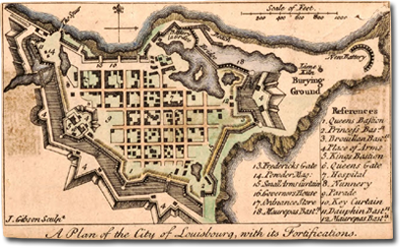 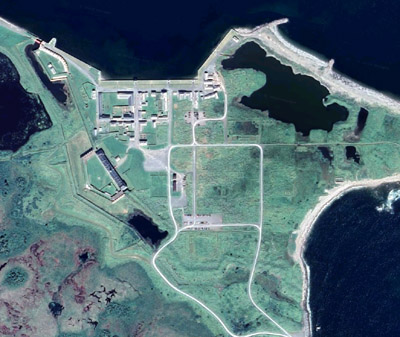 Louisbourg in 1758, soon after Britain acquired it; and Louisbourg's sadly diminished state today. Louisbourg in 1758, soon after Britain acquired it; and Louisbourg's sadly diminished state today. |
|
All of which context is fascinating, but perhaps we now might cast our gaze to a hill overlooking the confluence of the Avon and St. Croix Rivers, northwest of Halifax...at a little Acadian settlement called Pisiquid. Were *I* someone commanding a military force interested in relieving the British of Halifax in the mid-18th century, I would definitely consider the route up the Bay of Fundy, down the Avon and then overland about 30 miles to Halifax's potentially underdefended back door. The British could read maps too, and identified this hill where the Avon and St. Croix meet as a great place for a starfort...and that lots of Acadians lived around this area only served to make it a more attractive spot for the projection of British power. Or more specifically, a blockhouse! Often the starting point for a more serious fortification, a blockhouse was (and in some cases still is) a stout wooden structure meant to be used as a strongpoint containing troops and guns of one stripe or another. Such impressive edifices as Maine's Fort McClary, Georgia's Fort King George and Ontario's Fort Wellington are all examples of blockhouses-become-starforts. Not all blockhouses covered themselves in martial glory, however: The blockouse that preceded Maryland's Fort Washington creatively blew itself up during the War of 1812 when the British were (incorrectly) rumored to be approaching it from behind...but that blockhouse wasn't surrounded by helpful and protective outerworks, as were those others listed. |
Top: Fort Edward's blockhouse, along with the fort's barracks and an unidentified structure, from an early 20th-century postcard.
Bottom: See that? There's your proof that this is the most elderly blockhouse in North America, bolted right there on the side of the structure. |
 |
British Major Charles Lawrence (1709-1760) would become the governor of Nova Scotia following Old Man Cornwallis, but in 1750 he was an officer of the 40th Foot, charged with fortifying the aforementioned hill of our current interest. Unfortunately there was an Acadian church already occupying that hill, which problem was solved by the good Major compelling the locals to tear it down.
Initially known as Pisiquid Post (named for the town over which it menacingly sat) and/or West Point Blockhouse, the Fort to be known as Edward was armed with five 9-pounder guns, one 6-pounder and two 4-pounders. It housed eight officers and 168 men, and was, at least at first, intended to help prevent Acadians from fleeing Nova Scotia. Father Abbé Jean-Louis Le Loutre (1719-1772), a French priest, champion of the Acadian cause and by at least some accounts an extremely unpleasant person, was leading an army of Acadians intent on exiting their land, on their way to less English-dominated places. Father La Loutre made such a name for himself in this effort that they named a whole war after him!
Father La Loutre's War (1749-1755) pitted the Acadian Militia and Mi'kmaq warriors against the British, who were bringing Protestant settlers into the region, in the interest of making Nova Scotia less distastefully Catholic. |
|
The locals were understandably unhappy about the existence of Fort Edward, and small skirmishes broke out in the vicinity almost immediately upon its construction. Various British officers cycled through as commanders of the fort, and Captain Alexander Murray (1715-1762) made himself particularly unpopular during his period of command at Fort Edward by randomly imprisoning Acadian men and paying "unfair prices" for supplies he bought from the community. Yes sir, the English were doing their best to ingratiate themselves with the Acadians. They wanted the Acadians to stay at this point, didn't they?!
|
Father La Loutre's War was mostly about the Acadians and Indians attempting to slow the invasion of Protestant settlement into Nova Scotia, until the French could get their act together with a program of Acadian resettlement: Eventually, many displaced Acadians wound up in France's only other major toehold in the Americas, Louisiana, where their PR department cunningly rebranded the Acadians as Creoles. But Father La Loutre lost his war in 1755 at the Battle of Fort Beauséjour, and the British policy on Acadians was about to change: The Acadian Expulsion was on the horizon.
On October 20, 1755, 920 of Pisquid's Acadian residents were loaded onto British transport ships and removed from the situation...many to be imprisoned in the constellation of British starforts that had been sprinkled over Nova Scotia over the following nine years. Around 350 understandably ornery Acadians here held at Fort Edward at this time.
|
 |
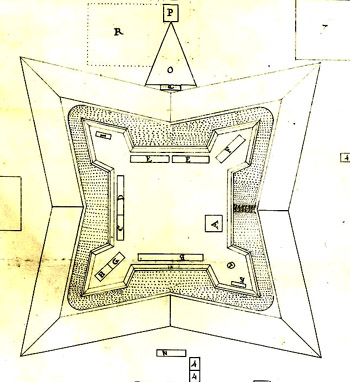 An Exact Plan of Fort Edward at Pesaquid, 1757 An Exact Plan of Fort Edward at Pesaquid, 1757 |
|
Perhaps uncoincidentally, the Acadian Expulsion overlapped with the French and Indian War (1755-1762). With the British and French in active conflict, why bother mollycoddling those pesky Acadians anyway? Get 'em out. During this war Fort Edward served as the British army's base of operations for the deportation of Acadians.
|
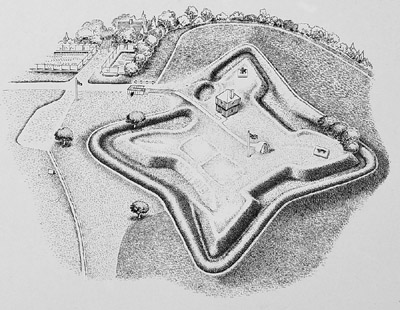 A lovely drawing of the spunky lil' Fort Edward, from a sign at the site. Thanks for visiting and enpicting way more forts than *I* have, Fortwiki.com! A lovely drawing of the spunky lil' Fort Edward, from a sign at the site. Thanks for visiting and enpicting way more forts than *I* have, Fortwiki.com! |
 |
Perversely, the Acadians who had been willing to go to war to leave Nova Scotia during Father La Loutre's War, resisted deportation in this present war. Which seems awfully flippidy-floppedy, but departing under their own terms, at their own chosen moment, was just about the only source of dignity the Acadians had left at this point.
Early in the war, the British troops on Nova Scotia were veritable prisoners in their forts, loath to step outside their gates. Mi'kmaq 'n' Acadian attacks occurred in 1756 and 1757 just outside Fort Edward, resulting in captured troops and burned storehouses. By the 1760's, however, it was illegal for Acadians to even exist on Nova Scotia, and those who somehow managed to remain there were arrested and imprisoned. |
|
Whilst incarcerated, the Acadians were forced to work on the farms now belonging to those "New England Planters" whom they had hoped to prevent from occupying Acadian lands.
|
Fort Edward was manned and ready to deter American overland advances on Halifax during both the American Revolutionary War (1775-1783) and War of 1812 (1812-1815), but star-spangled interest in Canada during those conflicts didn't extend much beyond Quebec and Ontario. Sailors from captured American privateer ships were held at Fort Edward during the Revolution.
The First World War (1914-1918) saw Fort Edward, like many of its counterpart Canadian forts, utilized as training facilities for troops headed for the hygenically enjoyable trenches of Europe.
|
 |
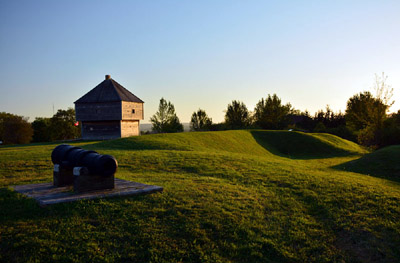 Today's gently rolling mounds of Fort Edward. Today's gently rolling mounds of Fort Edward. |
|
A British Army unit known as the Jewish Legion was established in 1917, and trained in Canada. Intended to fight the Ottoman Turks in Palestine, these men would ultimately use their British-taught fighting skills to fight those same British in the interest of gaining independence for Israel. "Camp Fort Edward" housed and trained 1100 members of this legion, one of whom being David Ben-Gurion (1886-1973), who would go on to become Israel's first Prime Minister. In 1918, the Canadian military finally said, it's the 20th century, what are we doing here, and Fort Edward was abandoned.
|
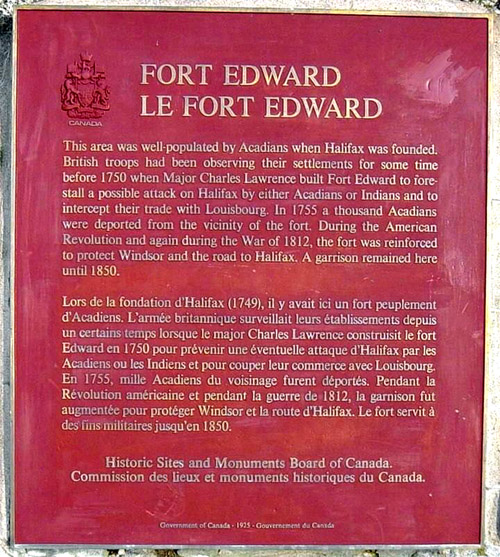 I did it to you again: Waited until the very end of the page to include the sign that you could have read instead of slogging through all of my turgid prose. You're welcome! I did it to you again: Waited until the very end of the page to include the sign that you could have read instead of slogging through all of my turgid prose. You're welcome! |
 |
Our fort was designated a National Historic Site in 1920, which honor did not prevent the fort's 1812 Officers' Quarters from burning down in 1922.
Today, Fort Edward's blockhouse is, as aforementioned, the oldest standing military blockhouse in North America, as well as the only blockhouse left on Nova Scotia.
Almost (but not quite) as impressively, the oldest continuous agricultural fair in North America is held at Fort Edward: The Windsor Agricultural Fair, established by those mean, Acadian-displacing New England Planters in 1765, is held annually in and around the fort.
Many thanks to alert starfort finder Ian Richard, who thoughtfully hipped us to Fort Edward! |
|
|
|
|
|
|
 |




